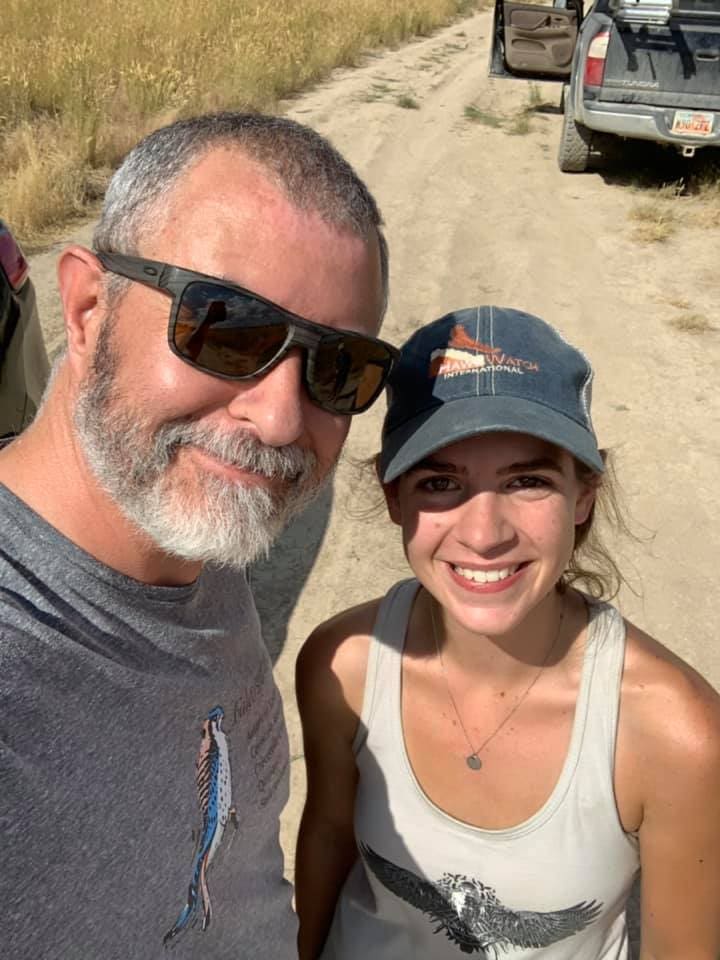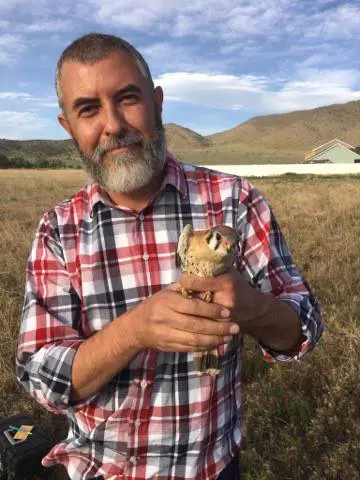The Kestrels will be getting some additional help this nesting season in Eagle Mountain. Two sponsors have teamed up with Hawkwatch International to provide an internship that will be able to help with the monitoring of the Eagle Mountain Kestrel Project nesting boxes. Tyson Foods and Ames Construction have both donated money and resources to the internship and the Eagle Mountain Kestrel Project. Through this partnership Hawkwatch International has secured enough funds to keep the internship running for the next two years with the goal of having two or three interns, this will take the internship into the year 2021.
Tyson Foods announced its plant and began to involve the community in early 2019. They invited members of the community to what they called a Community Leaders Meeting. Shon Reed met with Tyson’s executive team and through subsequent meetings developed a relationship with the company and invited HawkWatch International to participate. Dave Oleyar, Ph.D. with HawkWatch formed a partnership with Tyson and the Tyson grant came to fruition.
Colby Curtis, Eagle Mountain City Council, introduced Ames Construction and Shon Reed to discuss how they could manage their pending development and maintain as much raptor habitat as possible. Through the developing partnership between Ames Construction and the Eagle Mountain Kestrel Project their involvement with the internship program was started. In addition to providing money for the internship program they will be placing American Kestrel nest sites within the development and retaining some portion as wildland.
The interns will be responsible for helping monitor the nesting boxes in Eagle Mountain and other areas between Ogden and Provo Utah. They will shadow the Hawkwatch biologists and staff. Some of their responsibilities will include monitoring the boxes, mapping migration and movement patterns, branding projects, and tracking kestrel survival rates.

One interesting note is that Jennifer Bridgeman, the current intern, found a kestrel in Magna Utah that was a nestling from an Eagle Mountain nest box in 2017. The kestrel was hatched in Eagle Mountain and is now working on a kestrel family in Magna.
When asked about her experience as an intern, Jennifer responded with this statement. “The Hawkwatch American Kestrel Study provides me with an amazing opportunity to channel my passion for raptors into an important area of research and community outreach. Working on this project allows me to grow professionally in my career and as a person. Not only am I incredibly passionate about conservation research for declining raptors, particularly American Kestrels, but I also strongly advocate for citizen science in these types of wildlife studies. When I see real community involvement in conservation efforts for kestrels, it heartens me to see what a world of difference it makes not only for the birds and habitat but also for the people. This difference is readily apparent at Eagle Mountain, I quickly discovered, as every time we’d visit we were greeted by smiling, jovial community scientists, both young and old. This enthusiasm and joy were just as compelling as it was motivating for me. For this reason, I love visiting Eagle Mountain- this community is so engaged and excited about American kestrel conservation!”
There are three areas of study the Oleyar mentioned that Eagle Mountain was able to help them study. They are currently doing studies to see what effect rodenticides have on the Kestrel population as well as other bird populations. They have two ways that this internship is helping with that study. First, they are collecting what is called whitewash from the insides of the boxes. By collecting the bird’s fecal matter, they can test it to see if there are traces of rodenticide that may be affecting the birds. Second, they are drawing blood from the kestrels as part of the banding process. The blood is then tested for rodenticide as well. This will help them be able to see what effect local use of rodent poison is having on the Kestrel populations. They are also very interested in seeing how the Kestrels are able to cope with encroaching development. Eagle Mountain has nest boxes that are already established that have development moving closer daily. Part of the project is to see how development encroachment affects the population.

Monte Kingston, Director of Real Estate Development for Ames Construction answered a few of my questions about the internship and how Ames Construction will be working with the Eagle Mountain Kestrel Project in the future.
Q: Why did Ames Construction decide to team up with HWI and the EM Kestrel Project?
A: At Ames Construction, we take responsibility for protecting our country’s natural resources seriously. Environmental stewardship is embedded into our corporate culture, using the tagline: “Working in Harmony with Nature” since the early 1960s as a declaration and reminder of our commitment to environmental issues. Helping to preserve the wildlife habit in Eagle Mountain is a natural extension of how Ames works, and it is an effort in which we are proud to participate.
Q: What is the program going to be?
A: In response to fundraising efforts for HawkWatch International, Ames is participating in supporting an intern program for detailed data collection of the Kestrel habitat, and allowing the Eagle Mountain Kestrel Project to place Kestrel nest boxes along the perimeter of the Eagle Mountain development.
Q: What do you see as the future of this partnership?
A: Ames Construction recognized an opportunity to contribute to the welfare of wildlife populations by providing funds for this project. At this time, there are no plans to move beyond this effort, but we are more than willing to consider continued support of the natural resources at Eagle Mountain.
Q: Why do you and your company feel it is important to placing kestrel boxes along the perimeter of the development?
A: Most new developments destroy hunting grounds for the Kestrel falcon. In contrast, our project has preserved significant native open space – ideal for placing Kestrel nest boxes. Not only do the boxes benefit the Kestrel Project, but they also provide future residents with the opportunity to view Kestrel falcons in their natural habitat.

Melissa Clark, Eagle Mountain resident and City Council Member, loves what the Eagle Mountain Kestrel Project (EMKP) is doing for the community. “I have always loved the outdoors and the beauty of creation, but the EMKP has opened my eyes to the needs of our birds of prey, broadened my mind to the link between the health of our wildlife and the health of our community, and opened my heart to the many people who have committed their lives to keeping these beautiful creatures safe. It makes me even more proud to be a member of the EM community knowing the importance we place on even the tiniest among us. It is just good stewardship!”
If you want to see what these birds look like, and have a peek inside one of the Eagle Mountain kestrel boxes, you can check out the webcam that the project has installed inside on of the nest boxes in Eagle Mountain. Kestrel Webcam is now running 24 hours a day with views inside the nest box as well as outside the box. The Eagle Mountain Kestrel Project also has an Instagram feed and a youtube channel they post to regularly during the breeding season. The video collected will be shared with Hawkwatch International so they can study the kestrels food supply during this nesting season.
Mike Kieffer – Editor-in-Chief, Cedar Valley Sentinel
Mike Kieffer is a dynamic leader and community advocate based in Eagle Mountain, Utah. He serves as the Editor-in-Chief of the Cedar Valley Sentinel, a local publication dedicated to informing, inspiring, and elevating the Cedar Valley community through honest and accurate journalism. With a passion for fostering connections, Kieffer has made it his mission to highlight local businesses, provide reliable news, and support community development.
Beyond his editorial role, Kieffer is the owner of Lake Mountain Media, LLC, a company specializing in media and communications, and the co-owner of Quail Run Farms, which focuses on sustainable farming and community engagement. He also actively contributes to the local economy and culture as a member of the Eagle Mountain Chamber of Commerce.
Kieffer’s dedication extends to preserving and promoting the history and heritage of the Cedar Valley area. He often participates in community-centered events and media, including podcasts that explore the unique aspects of life in the region. Through his varied endeavors, he remains a steadfast advocate for the growth and enrichment of the local community.

